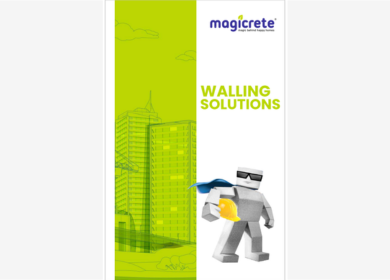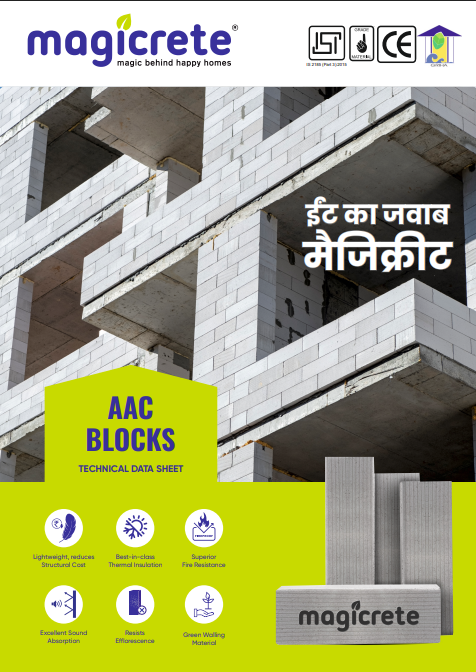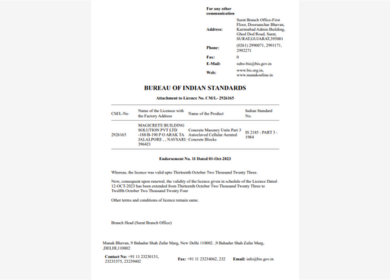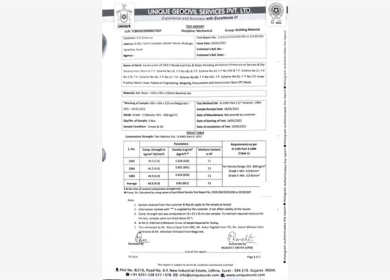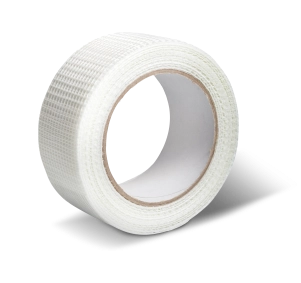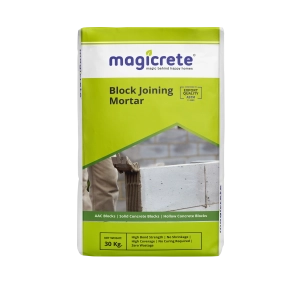AAC Blocks (Autoclaved Aerated Concrete)
Magicrete AAC blocks represent a new era in construction materials, offering unmatched strength, lightweight design, and eco-friendliness. Manufactured using fly ash, cement, lime, and aeration agents, our autoclaved aerated concrete (AAC) blocks adhere to IS 2185 Part-3 standards, ensuring top-notch quality. These blocks are an excellent substitute for clay bricks and concrete blocks, making them a green building product that reduces carbon footprint.
Constructed from recycled materials with zero wastage, Magicrete AAC Blocks accelerate construction by up to four times compared to clay bricks due to their size, dimensional accuracy, and easy workability. Magicrete also offers a variety of AAC block sizes to meet all your walling needs, and our AAC block prices are more economical than traditional red clay bricks, providing better value with faster construction and reduced material usage.
With unmatched properties including being super lightweight, non-combustible, and offering exceptional thermal and acoustic insulation, Magicrete autoclaved aerated concrete AAC) Blocks ensure a safe, durable, and comfortable living environment. Say goodbye to termites, rodents, pests, and fungal growth, as our blocks feature a solid construction that eliminates cavities.
Experience guaranteed savings with Magicrete AAC Blocks, reducing building foundation load by up to 28% and power consumption by 30%. Enjoy significant savings on steel and cement, with 15% and 12% reductions respectively.
Features

Lightweight
Boasts an exceptional lightweight nature, weighing only 1/3rd of red bricks. It reduces the overall structural load, resulting in cost savings of up to 15%.

Superior Strength
Offers a remarkable strength of 4N/mm2, surpassing the strength of red clay bricks.

Thermal Insulation
Boast industry's highest thermal rating of 0.16 W/(m⋅K), AAC blocks ensure 30% lower HVAC expenses, reducing heat transfer and improving indoor temperatures.

Earthquake Resistant
Lightweight AAC Blocks exhibit remarkable earthquake resistance, preferred in seismic zones, and proven to withstand Category 5 wind loads.

Fire Resistant
Its unique cellular structure provides unbeatable resistance against flames, with a best-in-class fire rating of more than 4 hours.

Sound Resistant
Closed air pockets in AAC blocks yield an STC rating of 44, offering superior sound insulation for virtually soundproof interiors.
Technical Specification
| PARAMETERS | SPECIFICATIONS |
|---|---|
| Density | 550-650 kg/m3 (Oven Dry) |
| Compressive Strength | 4 N/mm2 |
| Modulus of Elasticity | 2040 N/mm2 |
| Coefficient of Thermal Expansion | 8.1 x 10 -6 K -1 |
| Water Absorption | 8% (at equilibrium) |
| Drying Shrinkage | 0.04% |
| Thermal Conductivity | 0.16 W/m2K |
| Fire Resistance | 4 Hrs. (150mm wall) |
| STC Rating | 43db (100mm wall) |
AAC Blocks Calculator
Walling Technology Comparison
| Parameters | AAC Blocks | Concrete Block | Red Clay Brick |
|---|---|---|---|
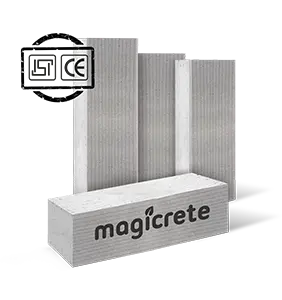 |
 |  |
|
Eligible For Green Points Under GRIHA/IGBC |
Yes |
Yes |
No |
Fire Rating (150 mm) |
4 Hours |
3 Hours |
2 Hours |
Thermal Conductivity |
0.16 W/m2K |
2 W/m2K |
0.18 W/m2K |
Water Absorption |
Low |
Average |
High |
MEP Installation difficulty level |
Minimal |
Very High |
Medium |
Earth Quake Resistance |
Highest in category |
Low |
Low |
Speed of Installation (1 Mason + 2 Helpers) |
35 m2/day |
18m2/day |
10m2/day |
Dry Density |
550-650 Kg/m3 |
2400-2500 Kg/m3 |
1800-2000 Kg/m3 |
Energy Saving |
High |
Low |
Low |
Pest and Termite |
None |
None |
High |
Sound Reduction Index (100 mm) |
43 dB |
41 dB |
40 dB |
Material Composition |
Fly Ash, Gypsum, Lime, Cement, Aluminium Powder |
Cement + Sand + Gravel |
Top Soil |
Knowledge Base
Project Gallery
FAQs
Related Products
Related Blogs
Build Smarter, Faster, Greener with Magicrete AAC Blocks
Magicrete AAC Blocks are changing the way India builds. They help speed up construction, offer great thermal insulation, and reduce dead loads. Our modern manufacturing and broad network help us provide more than just products. We tackle real building challenges with effective solutions.Whether you're a contractor, architect, builder, or homeowner, Magicrete is here for you. We focus on improving construction efficiency, cutting costs, and providing lasting durability.
Why Magicrete Is a Preferred Choice for AAC Block Buyers
- Precision Engineered: Consistent quality and finish for hassle-free installation
- Thermal & Sound Insulation: Keep interiors quieter and more energy-efficient
- Lightweight, Yet Strong: Reduced structural load = savings on steel and cement
- Eco-Friendly Choice: Made from fly ash, it helps reduce the carbon footprint
- Strategically Located: Manufacturing units are strategically located near major urban centers
Interested in how AAC blocks compare to traditional red bricks? Read our latest blog: AAC Blocks vs Red Bricks?
Competitive AAC Block Pricing – Backed by Dealer Support
Magicrete offers great prices on AAC blocks. This applies to bulk orders, projects, and small builds. We keep quality high. Our network of trusted dealers and contractors gives you local support. You’ll get on-time supply and customized solutions in every region.
Ready to Build Better with AAC Blocks?
Let us help you get started with the right AAC solution for your project. Connect with our local dealers, request a quote, or speak to a product specialist today.
Talk to an Expert | Find a Dealer Near You | AAC Block Near Me | Request Bulk Pricing


